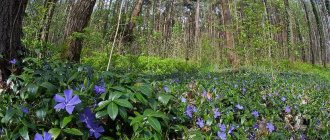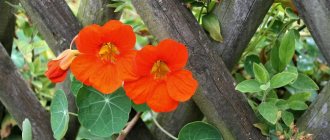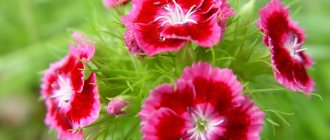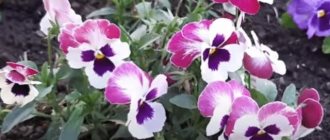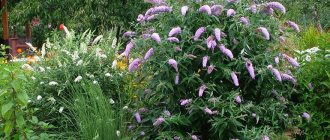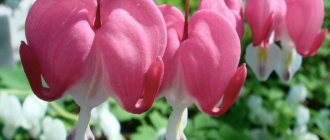Saxifraga is a herbaceous plant that can be either annual or perennial. It is often used in landscape design. Saxifraga forms a continuous carpet. The flowering period occurs at the end of spring and throughout the summer.
There are approximately four hundred varieties of saxifrage. This plant is quite unpretentious. Saxifraga is common in Eurasia, Central America and the mountainous parts of the African tropics.
The size of the plant can be different: from 5 cm to 0.7 m. It can form a carpet of varying thickness. Saxifraga is a rhizomatous plant species. The basal rosette is formed by leaves, which may have a gray tone, as they differ in the property of accumulating lime.
The flowers have five petals and can be of different colors: white, soft pink, lilac, sunny yellow. There are varieties of saxifrage with bright scarlet flowers.
This plant is used both for decorating the local area and for keeping in the house.
Description
Saxifraga belongs more to mountain plants, as its name suggests. It prefers to grow between stones with a minimum of nutrients and poor watering, but is a bright spot in any landscape design with stones. In addition, some varieties are used not only to create beautiful compositions; in medicine, medications necessary for many are made from all parts of the plant.
Saxifraga (Saxifraga Caespitosa)
The natural habitats of the species are Eurasia, Central America, and mountainous areas of tropical Africa; it is under such natural conditions that the trunk can develop perfectly. Saxifraga can be either an annual or a perennial; now there are more than 400 species of this plant. The trunks bloom from May to August.
They differ from each other in external characteristics:
- come in different sizes
- can be grown both in open ground and in pots
The leaves can also be a distinctive feature; in some species they are very small, and in others they are medium in size. There is a saxifrage whose foliage grows only 5 cm, some species can grow up to 70 cm in height. In this case, the bushes of the plant will completely cover the soil with a radius of up to 12 cm.
The leaves of saxifrage are collected in a basal rosette, usually green. Sometimes the leafy part may have a bluish tint; this occurs due to the plant’s ability to accumulate lime. Each leaf has several flower stalks, on which flowers of different colors with five petals open over time.
Saxifraga paniculata
Flowers usually have delicate shades: pink, white, purple, yellow, some varieties are distinguished by red flowers. Some species have paniculate inflorescences, are cold-resistant and differ from their relatives in their complex root system. After flowering, in place of each flower, a seed box with a large number of small grains is formed. When sowing, not all will sprout; many will die from excess moisture.
Indoor varieties are most often hanging, grow and develop well on northern windows, but they still need light. This flower is easy to care for and plant; even a novice gardener can grow it both indoors and in the garden. Saxifraga will do well without moisture and will grow even if it is not regularly fertilized.
Indoor saxifrage
A genus of plants such as saxifrage (Saxifraga) is directly related to the saxifrage family (Saxifragaceae). It unites more than 400 species of herbaceous plants, among which most are perennials, and the rest are annuals or biennials. She prefers to grow in nature in places with harsh climates. So, this plant can be found in the subarctic regions, in the Alps, in eastern Greenland, as well as in the western and eastern parts of the Himalayas. Saxifraga prefers to settle on rocky embankments, in rock crevices, on masonry walls, and is also found in lowland meadows.
The roots are poorly developed due to the soil in the places where this plant prefers to grow. The root system is almost fibrous, but there are a few small roots. The foliage of almost all species of plants of this genus is either located right at the very surface of the soil, or is collected in dense basal rosettes. Her peduncles are long and single. They emerge from the middle of a rosette of leaves. Racemose inflorescences are few-flowered. The flowers have 5 petals and are most often radially symmetrical. It blooms for a very long time, about 3 or 4 weeks.
Other characteristics of saxifrage vary significantly among different species. So, the height of a bush can reach either 2 centimeters or 100 centimeters. The leaves are either petiolate or long-petioled. Their edges can be smooth or significantly rugged. Flowers can be painted in different colors. They also come in very small sizes and inconspicuous appearance, and there are also very large, showy flowers with rich colors. The petals can be either narrow-lanceolate or rounded.
Types and varieties
There are more than 400 species of saxifrage in nature , some of them are grown in the garden, others are preferable to have on the windowsill. The plant is not picky in its care and endures all difficulties and hardships.
Saxifraga is often used in landscape design; with the help of the flower you can create magnificent compositions. It is often used as a border plant, sometimes flower beds are decorated with saxifrage so that it seems that a flower blanket has covered a certain area
Saxifraga alba
Rocky places can be improved with low-growing plants of mountain origin. The varieties feel great between stones and will gradually cover everything around with variegated small flowers.
Not all species are used by flower growers; some remain wild. No more than a dozen are popular, now we will look at them in more detail.
Arends
The low-growing hybrid is a great success among flower growers and landscape designers. It is used to add zest to classic front gardens; the plant also looks great in the modern design of flower beds in the yard.
Saxifraga Arends
With the help of the species, the effect of a flower carpet is achieved on any type of soil, even in the most remote and shaded corners of the garden. Arends' saxifrage is one of the decorative hybrids that are grown outdoors.
The hybrid feels best in the north, where the climate and soils are ideal for it. Saxifraga is planted in groups to quickly achieve the desired effect.
The main characteristics are:
- the plant reaches 10-20 cm in height
- bushes often intertwine with each other
- the leaves are small, separate, have a rich green color
- flowering occurs in May-June
Suitable only for growing in flower beds; as a houseplant it does not grow well. And then he dies.
Most often, the following varieties are used in garden and garden design:
- Purpurmantel , whose name speaks for itself. The plant has low, up to 20 cm, stems with purple-pink tassels.
- Bluetentheppich forms a 15 cm mat of bright red flowers. The plant's decorative properties are excellent; it is often used as a border plant, but excess bushes are regularly removed.
- Schneeteppich will help create a snow-white carpet in the summer. The rich greenery of the leaves hardly breaks through the many white flowers; the leaves can reach 10 cm in height.
- The flamingo has an identical color to the bird; the delicate flowers will fit perfectly into any landscape design and become an integral part of it. Seeds and seedlings of the variety are not yet very common in our country, but this will not last long, Flamingo is successfully gaining momentum.
- Peter Pan will fit perfectly into an alpine hill with any other ornamental plants; small pink flowers with yellow centers will not leave anyone indifferent. The openwork of small leaves is visible between the flowers and this gives a special charm to the variety.
Bedrenets
A herbaceous perennial, saxifrage, which is rarely grown for decorative purposes . The stem can reach 70 cm in height, has umbrella-like inflorescences that are not at all attractive, but is an indispensable raw material in pharmacology. The distribution area is limited to the European part of Siberia and the Caucasus. It is found in pine forests, in glades and forest edges, and on grassy slopes of mountainous areas.
Saxifraga Bedrenets
Flowering occurs in May-June; the flowers themselves are unremarkable, small, white, collected in large umbrellas. All parts of the plant are used to produce medicines, the seeds and leaves are especially valued.
Soddy
The soddy type of plant came to us from the northern regions of Eurasia and North America. The trunk is characterized by a dense basal rosette of leaves, the lower ones have significant branches, the lower ones are more dense and erect. The leaf plates are painted dark green, the lower ones have pronounced veins.
Saxifraga Soddy
The flowering of Saxifraga turf is not long, usually no more than three weeks, but very beautiful. Small flowers can be pink, red, white. During the flowering period, the stem looks like a large pillow with a colored print. You can admire the beauty in June; depending on weather conditions, sometimes flowering is postponed to July.
Indoor view
Indoor saxifrage varieties are ideal for growing by amateur gardeners . Its unpretentiousness and excellent decorative qualities allow it to be used in the most northern and dimly lit rooms. The ideal microclimate for the plant will be dry and cool air, which is often observed in our apartments in winter.
Homemade look
The homeland of the trunk is the mountainous regions of Japan and China, where with the help of shoots the plant clings between stones, then small roots are formed, which obtain food for themselves on these poor soils. Gradually, the roots stimulate the growth of new leaves, and a new bush is formed.
The indoor species differs from other varieties of saxifrage in having larger leaf blades; in addition, the staff will have a large number of tendrils, which look very impressive in a hanging pot.
Indoor saxifrage can be combined indoors in multi-level pots with petunias, such a neighborhood will have an excellent appearance.
The only important condition for home cultivation is minimal lighting; in bright light, the leaves of indoor saxifrage will become faded and inconspicuous. Gradually the flower will begin to hurt and may die. The plant needs minimal watering; it is better to use light soils with a high sand content.
Some species of saxifrage are listed in the Red Book and are protected by law.
Cotyledon
Cotyledon - cotyledon leaves that appear above the soil surface after seed germination.
Cotyledon. Homeland - South and South-West Africa, Ethiopia. This is, first of all, wavy (C
undulata), attracting attention by the shape of thick fan-shaped leaves with beautiful wavy edges, and especially by their color - they are covered with a strong waxy coating, giving the plant a bluish tint. Representatives of the genus Cotyledon are distributed from South Africa through Ethiopia to the Arabian Peninsula
Representatives of the genus Cotyledon are distributed from South Africa through Ethiopia to the Arabian Peninsula.
Flowers 5-membered; petals fused into a tube; the stamens are arranged in two circles (see Fig. 85).
A waxy coating on the leaves gives many succulents a peculiar light blue color (cotyledon rounded from coll.
The hanging tubular flowers of some species of Kalaichoe (for example, Kalanchoe pinnate), as well as the flowers of Echeveria and South African species of Cotyledon, are pollinated by birds. The bird inserts its beak and the front part of its head into the long tube of the corolla, sucks nectar and performs pollination.
This genus includes both leaf and stem succulents. While the former are relatively famous, the latter are extremely rare and can grace any collection. Token (1978) divided Cotyledon into two genera: Thylecodon and Cotyledon. But this innovation has not yet been accepted everywhere in the literature.
Most Crassulaceae usually grow in more or less dry, open places, very often among stones and in rock cracks. Sometimes they are found in bushes, meadows and shady gorges, and some species even live in water (C. aquatica). Crassulaceae are found from sea level to the alpine belt. Sometimes they are edificators of vegetation cover. For example, in the Cape region, both on the coast and in the mountains, associations of tree-like crassulas are widespread, dominated by species of the genus Golyledon. Sedum (S. acre) produces a luxurious yellow carpet during the flowering period. Widespread throughout Europe, this species prefers dry, upland areas with sandy soils.
Spring is a favorable time for propagating indoor plants. Most often, vegetative propagation is used, i.e. propagation by parts of the plant itself, since in this case it is possible to obtain an adult plant in a shorter time than sowing seeds. The basis of all methods of vegetative propagation is the ability of most plants to regenerate, that is, to restore lost parts. Methods based on the use of specialized reproductive organs (rhizomes, creeping shoots, tubers, bulbs) are widely known. Rhizomes are underground stems that form not only roots, but also protruding adventitious buds called buds. When transplanting aspidistra, sansevieria, and calamus, the rhizomes are cut into parts containing eyes and planted in separate pots. The dallalia fern reproduces in the same way. On the creeping shoots of these plants, small daughter plants are formed, which easily take root when in contact with the soil. Another type of underground stem, the tuber is a thickened and short underground shoot that bears many buds. Tubers of calla lilies, zantedeschias, and tuberous begonias can be divided into as many parts as they have eyes (like potatoes). Eucharis, amaryllis, crinum, hymenocallis are propagated by bulbs in which the stem is represented by a bottom bearing fleshy leaf-like scales. Small onions are usually separated from old ones during transplantation after flowering.
Reproduction methods
To get a good, healthy plant, you need to propagate it correctly. Saxifraga is no exception to this; simply tearing off a branch and sticking it into the ground will not work. There is only a small chance that the plant will take root after this method; in order to be sure to have saxifrage in your garden or home, you will have to study all known methods of its propagation.
Young plant seedlings
The standard is propagated in several ways:
- seed, carried out by sowing purchased seeds in the ground or through growing seedlings
- by cuttings, through planting young branches with roots taken from whiter adult plants
- layering, when the side branches are cut off and transplanted to the right place
- dividing the rosettes, it is important to preserve the rhizome on each part
Each of the methods is carried out in early spring or before winter , but it is worth counting so that the cutting or divided bush has time to take root in a new place.
You should not expect sprouts from seeds sown before winter; the plant will make itself known in early spring. The bole will bloom in June-July; in the first year it may not be abundant. In the future, the saxifrage will only grow and delight the eye with a colorful blanket.
Propagation by seeds
Growing by seed
The seed propagation method most often involves growing seedlings in closed ground, and then planting young plants in open ground . But some gardeners practice sowing seeds directly into the ground.
For that. To obtain the maximum possible number of saxifrage seedlings, it is necessary to sow the grains correctly.
The procedure is carried out as follows:
- It is first necessary to statify the seeds; to do this, add a little ordinary sand to them, pour them into a container and place them on the top shelf of the refrigerator for 2-3 weeks;
- the next step will be direct sowing into a container with soil; for this, the soil is lightly compacted and sprinkled with seeds and sand, watered;
- It is advisable to cover the container with glass or wrap it with film, this creates a greenhouse effect that accelerates the germination of plants;
- the first shoots will hatch within 10 days, then the plant will begin to develop more rapidly;
- When the trunks have four true leaves, it is advisable to plant them in separate pots, this will allow them to grow faster and simplify transplanting into open ground.
After this, they wait until the soil warms up enough and plant the saxifrage babies in the prepared soil. The first days you can water the plants moderately, and then you should exclude water altogether for the benefit of the plants.
It is worth understanding that the plants will show themselves in all their glory only in a year; this season will pass without flowering.
Planting seedlings in open ground
Although saxifrage is considered a frost-resistant plant , seedlings are planted only after frosts on the ground have passed. After this, young plant seedlings can be planted in the prepared area of the flowerbed or garden.
Plant ready for transplanting into open ground
To do this, the pots with seedlings are well watered, the soil is loosened in the chosen place and depressions are made. A seedling with a lump of soil is placed in each hole, sprinkled with soil from the garden bed, and lightly compacted.
There is no need to carry out additional watering; the moisture already received will be enough for the trunk. The next watering can be done after 5-7 days if there was no precipitation during this period. The bushes should be placed according to a 20x20 cm pattern, so that they have room to grow later.
Sowing in the ground
It is also practiced to sow seeds in open ground; for this, it is also necessary to prepare the grains . There is no need to statify them, this process will take place naturally during the wintering period, but it won’t hurt to disinfect them.
Sowing seeds in open ground
To do this, the grains are soaked for several days in a weak solution of potassium permanganate or any fungicide . Afterwards it is dried and mixed with sand. In the selected area, shallow furrows are made, up to 1.5 cm, and the seeds are sown. The furrows are lightly covered with garden soil and watered.
It is best to carry out the procedure in early spring, but sowing is also possible before winter. You should not expect 100% germination; saxifrage does not reproduce well using this method. In the spring, after 25 days after the procedure, no seedlings have appeared, you can safely plant other plants in this place, saxifrage will no longer appear.
Cuttings
Cutting scheme
Using this method, propagation is carried out in July, after the end of the flowering period of the trunk.
To do this, do the following:
- wet sand is collected in a box or container;
- in an adult plant that is more than two years old, several young side shoots are cut off;
- It is advisable to treat the cut with crushed charcoal to protect both the plant and the cuttings from diseases and pests;
- the cut parts are rooted in a container with sand, and in the fall they are planted in a permanent place;
- You can leave young seedlings to overwinter in the sand; for this, select a cool place with low light;
- In the spring, overwintered cuttings are planted in open ground in the same way as saxifrage seedlings.
Update the plant stems in a timely manner, then the flowerbed will always look great. Saxifraga has a spectacular appearance for 5-6 years, then it needs to be replaced with a young plant.
Dividing the bush
This method is the most common; most often, gardeners renew saxifrage or share plants with just a piece of the bush. Every spring, warmth and moisture stimulate the plant to send out additional side shoots and roots. Gradually they turn into a full-fledged plant, which is connected to the main trunk by leaves. It is in this place that it is worth separating the young growth, but this should be done only after the end of flowering.
Bush division scheme
A shoot is cut off from an adult trunk with a sharp knife; it is advisable to treat the cut site with wood ash. The resulting plant is treated with fungicides and planted in pre-prepared soil according to a 20 cm x 20 cm pattern. By winter, the young plant will take root, and in the spring of next year you can expect the first flowers.
Layerings
Reproduction by layering is quite popular; it does not require a lot of time and effort. It is enough to take a longer side branch, make a small depression under it, and water it . Next, lay the cuttings and lightly sprinkle them with garden soil and press down a little.
Reproduction scheme by layering
Periodically, in the absence of precipitation, the cuttings must be watered with small portions of settled water. In the fall, the cuttings will already have their own roots, but there is no need to trim them; it is better to do this in the spring. It is advisable to sprinkle the cuttings with ash, and transplant the cuttings along with the earthen ball to a permanent place of residence.
To ensure reliability, the cuttings can be pinned with small spikes made of wood or metal, and mulched with peat for the winter.
How saxifrage propagates by cuttings
Cuttings are carried out after flowering. Cuttings 8–11 cm long are cut from the mother bush. The cutting areas are treated with charcoal, the lower leaves are removed. After this, the cuttings are buried in the soil and covered with a plastic bag on top to create greenhouse conditions. Place in a warm, shaded place before rooting. Moisturize as needed, remove the cover daily for 2 - 3 hours. When the cuttings take root, the shelter is removed and care for the young plants continues.
This video demonstrates the work of growing saxifrage flowers at home, which shows all the nuances of this work:
Care
Saxifraga is considered a favorite of flower growers because of its ease of care, but in order to have a beautifully designed ridge, an alpine hill, or just a certain area of the garden, the plant must be surrounded with care. There are no particular difficulties in this, but the process must be taken responsibly.
Saxifraga Peter Pan
In order for the selected saxifrage variety to bloom and grow, it is necessary to provide it with the following conditions:
- First of all, we choose the right place, it should be shady; direct sunlight will soon destroy the garden flower.
- Before planting, pay attention to the soil; it should not be heavy or have stagnant moisture.
- During the growing season and flowering, saxifrage is rarely watered. It is necessary to moisten the soil only in cases where there is no precipitation for more than a month. But at the same time, moderate watering is carried out, preferably flowing, but this depends more on the soil.
- Loosening the soil around saxifrage plantings is necessary; this will protect the trunk from stagnation of moisture. Provides oxygen access to the root collar.
- Weeding is also an important element of care; weeds will not contribute to the growth and development of the flower carpet, so it is better to remove them promptly and regularly.
- Pruning will help maintain the attractive appearance of garden plantings; after flowering, it is necessary to remove all dry flower stalks and leaves.
In addition, a couple of times a month, adult trunks need to be fed to stimulate flowering and better growth to the required areas. It is worth considering that not everything is suitable for saxifrage; first carefully study the necessary information. Universal garden products will not be suitable, but now we will find out which ones will be ideal.
Plant nutrition
It is necessary to stimulate growth and support the plant during the flowering period with fertilizing, but it is important to know which ones are suitable and will not destroy the plant. Saxifraga is picky; nitrogen-containing substances have a negative effect on it; a complex of mineral substances would be an ideal option.
Saxifraga oppositeifolia
But they must be introduced using a special method:
- The fertilizers chosen for saxifrage must be applied along with watering.
- Before preparing the solution, be sure to read the instructions and use exactly half the specified amount of the substance for the indicated amount of water.
- Mix thoroughly and water the plants.
It is advisable to loosen the soil well before applying, remove weeds and excess plants from the flowerbed area.
Much does not mean good, this rule is effective for feeding saxifrage. Excess nutrients will only harm the plant, can cause diseases, attract pests, which will completely destroy the plantings.
Preparing for winter
All varieties of saxifrage tolerate winter cold and frost well, since most varieties come from ancestors from the north. But still, some varieties need help in wintering in order to protect and preserve them.
Juniperus saxifraga
An important point for her will be the preservation of the shoots during reproduction; they must be mulched for the winter with peat or dry small sawdust, and covered with leaves or spruce branches on top.
Well-rooted plants tolerate winter well; their preparation consists of completely cutting off the above-ground part of the plant and covering it with dry leaves or spruce branches. The layer should not be very thick so that air flows normally, otherwise the plants can support and provoke the development of putrefactive diseases.
The soil
The saxifrage plant came to our gardens and flower beds mainly from mountainous regions or from very poor soils that were not suitable for most plants. She learned to take the most from such soil, to survive on it and at the same time to bloom. On good soils rich in nutrients, the plant is unlikely to please with lush greenery and flowering.
Saxifraga Arends
To give the hybrid the opportunity to fully develop, provide it with the right soil, on which it will please the eye for a long time. To do this, it is advisable to remove the top layer of garden soil before planting seedlings, and fill it with a specially prepared soil mixture.
It is unlikely that you will be able to find such a composition in the store, so it is better to make it yourself, for this you will need:
- peat
- greenhouse or garden soil
- lime
- sand
- fine gravel
The first four ingredients are taken in the same proportion, and it is enough to add a handful of pebbles to 5 liters of ready-made soil mixture. The prepared soil is laid on the places where saxifrage grows in the fall, during the winter and early spring it will become compacted, after which it will be possible to plant the plants.
Remove the soil to a depth of 20-30 cm, it is no longer worth it, the roots of decorative saxifrage do not penetrate very deeply.
When sowing seeds and propagating by cuttings, it is advisable to use the same soil; on heavier ones, young plants may not take root or may constantly get sick and wither.
Prevention
Diseases can be treated in various ways, but it is much easier to prevent their development
To do this, it is important to remember that even the most moisture-loving plant can die from too much water. To treat the most common diseases, such as fungi and rot, you need to carefully examine the plant affected by the disease and carefully separate the damaged parts
There are also some products that help very well in destroying fungus (HOM, topaz, etc.).
Treatment of saxifrage
Arends' saxifrage is a flower for all occasions: both practical to use at home and beautiful for design. If all conditions are followed correctly, the plant will delight residents and guests with its variegated, lush color.
Diseases and pests
Plant requiring attention
All varieties and types of saxifrage are characterized by increased resistance to many diseases and plant pests.
But sometimes, under certain circumstances, the trunk can be affected:
- fungal diseases
- root rot
- powdery mildew
- mealybug
- spider mite
- aphids
Root rot is a consequence of fungal diseases that occur as a result of improper watering or poor soil drainage . The methods of combating these diseases are drastic; diseased plants, along with their rhizomes, are removed from the flowerbed. The vacated space must be treated with fungicides and the soil replaced.
Literature
- Kudryashova G. L.
Saxifraga nivalis L. - Snow saxifrage // [herba.msu.ru/shipunov/school/books/tzvelev2001_fl_evr_chasti_10.djvu Flora of Eastern Europe] / Rep. ed. and ed. volumes N. N. Tsvelev. - St. Petersburg: Peace and Family; Publishing house SPHFA, 2001. - T. X. - pp. 291-292. — 670 s. — 700 copies. — ISBN 5-8085-0122-9. - Lozina-Lozinskaya A. S.
[herba.msu.ru/shipunov/school/books/flora_sssr1939_9.djvu Saxifraga nivalis L. - Snow saxifrage] // Flora of the USSR: in 30 volumes / ch. ed. V. L. Komarov. — M.—L. : Publishing House of the USSR Academy of Sciences, 1939. - T. IX / ed. volumes S. V. Yuzepchuk. — P. 152-155. — 540 + XIX p. — 5200 copies. - Malyshev L.I.
Saxifraga nivalis L. - Snow saxifrage // [herba.msu.ru/shipunov/school/books/flora_sibiri1994_7.djvu Flora of Siberia. T. 7: Berberidaceae - Grossulariaceae] / Comp. G. A. Peshkova and others: In 14 volumes - Novosibirsk: VO Science; Sib. published firm, 1994. - T. 7. - P. 190. - 312 p. — 1200 copies. — ISBN 5-02-030578-2.
Compatibility in landscape design
The low-growing flower is often used in landscape design in various combinations . Its excellent ability to survive and grow on the poorest soils allows it to improve and tidy up the most unfavorable areas of the garden. It is enough to sprinkle rocky areas with a thin layer of garden soil and plant a couple of saxifrage bushes there; in a couple of years there will be a dense carpet of lush greenery and variegated small flowers.
Alpine slide
In addition to single plantings, saxifrage is actively used for ridges and alpine slides; the trunk looks especially impressive with low-growing flowering specimens. Ideal options would be irises, phlox, tiarella.
As borders, saxifrage is combined with purslane , but this proximity will not last long; purslane must be constantly reseeded.
Large tubs with saxifrage are very popular ; in winter they are admired indoors, only the temperature is selected accordingly.
Growing saxifrage at home
This flower is completely unpretentious to care for!
If you wish, grow it as an indoor crop. I recommend placing the pot of saxifrage in the sun, shaded with a curtain. When planting a flower in the garden, keep a distance between specimens of 16 - 18 cm. Saxifraga will grow quickly if the soil in the area is slightly alkaline. Before planting this crop, you need to carefully dig up the soil. It is recommended to first clear it of weeds and debris. If the soil on your site is poor, enrich its composition by adding:
- a small amount of slaked lime;
- clean sand;
- peat.
I advise you to keep the culture at a temperature of + 21 to + 26 degrees. In winter, she has a rest period: the temperature should be lowered to + 14 degrees. If you are growing variegated saxifrage, lower the air temperature to + 16 degrees.
Plant properties
Saxifraga shady variegata
Almost all types of saxifrage from the garden have medicinal properties; everything useful for the human body is found in the leaf blades:
- alkaloids
- flavonoids
- organic acids
- vitamins
- fatty acid
These substances have antitumor, antihemorrhoidal, and antiseptic properties. The decoction calms exacerbation of asthma, relieves symptoms of vomiting and infectious diseases, inflammation of the genitourinary system and liver. Fresh leaves will alleviate the condition and help eliminate purulent rashes on the skin.
You can use saxifrage as a medicine only after consulting with a specialist; uncontrolled use can negatively affect human health.
Botanical characteristics of the flower
Depending on the species, the height of saxifrage can be within 65 cm. The stem of this plant is short or elongated, the roots are branched, the leaves are small, petiolate in type. The leaves of saxifrage form a small rosette near the root system. They are:
- elongated;
- diamond-shaped;
- in the shape of hearts;
The leaves also differ in color and can be light, dark, or bluish. As saxifrage grows, its leaves become covered with plaque.
In summer the plant produces flowers. They themselves are small, located on corollas, the size of which does not exceed 20 cm. Certain types of saxifrage are very similar to bells. Most varieties have white flowers, but yellowish and scarlet ones are also found.
The peculiarity of saxifrage is that it pollinates independently. In autumn, the plant sets fruits - seed pods. These boxes contain oblong seeds.
Mulching, loosening
Stagnant moisture is a problem that causes the roots and leaves of saxifrage to rot. It is useful to periodically loosen the soil around ground cover plants. A sufficient level of aeration has a positive effect on the growth of any flowers, including saxifrage.
Mulching is an effective method of retaining moisture. Interestingly, medium-sized stones are often used to cover the soil around plants. Under dense cover, weeds practically do not grow. Before forming a layer of mulch, be sure to moisten the substrate.
